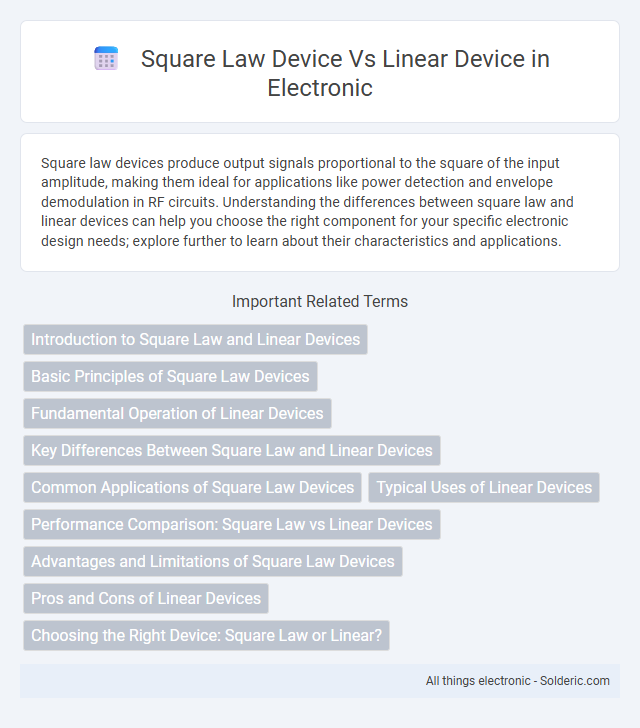Square law devices produce output signals proportional to the square of the input amplitude, making them ideal for applications like power detection and envelope demodulation in RF circuits. Understanding the differences between square law and linear devices can help you choose the right component for your specific electronic design needs; explore further to learn about their characteristics and applications.
Comparison Table
| Feature | Square Law Device | Linear Device |
|---|---|---|
| Output Relationship | Output Input2 (quadratic) | Output Input (linear) |
| Applications | Power detection, RF demodulation, envelope detection | Signal amplification, linear amplification, analog processing |
| Linearity | Non-linear | Linear |
| Signal Distortion | Higher distortion due to nonlinearity | Minimal distortion, faithful signal reproduction |
| Frequency Range | Typically high-frequency (RF/microwave) | Wide frequency range, depending on design |
| Complexity | Simple structure for power detection | Often more complex for linearity preservation |
| Examples | Diode detectors, square-law mixers | Operational amplifiers, linear transistors |
Introduction to Square Law and Linear Devices
Square law devices operate based on the principle that their output voltage or current is proportional to the square of the input signal, commonly found in applications like RF power detectors and mixers. Linear devices maintain a direct, proportional relationship between input and output signals, essential for amplifiers and modulators to preserve signal fidelity. Understanding the fundamental differences in their transfer characteristics is crucial for selecting the appropriate device in communication and signal processing systems.
Basic Principles of Square Law Devices
Square law devices operate based on the principle that their output is proportional to the square of the input signal amplitude, making them highly effective in detecting power, envelope, and intensity in RF and microwave applications. Unlike linear devices that maintain a direct proportionality between input and output signals, square law detectors produce a nonlinear response that enables them to measure signal strength accurately at low power levels. This fundamental characteristic is crucial for applications such as demodulation, power measurement, and signal processing in communication systems.
Fundamental Operation of Linear Devices
Linear devices operate by maintaining a direct proportionality between the input signal and the output current or voltage, ensuring the output waveform remains a scaled version of the input without distortion. This fundamental operation allows for accurate amplification and signal processing in communications, sensors, and analog circuits. Linear devices include transistors and operational amplifiers, which are essential for precise, low-noise electronic applications.
Key Differences Between Square Law and Linear Devices
Square law devices output a signal proportional to the square of the input voltage, making them ideal for power detection and envelope detection applications. Linear devices maintain a direct proportionality between input and output voltages, ensuring minimal distortion and accurate signal amplification. The key difference lies in their transfer functions, with square law devices exhibiting nonlinear behavior and linear devices providing consistent gain across input levels.
Common Applications of Square Law Devices
Square law devices are commonly used in RF and microwave applications such as power measurement, envelope detection, and frequency discrimination due to their nonlinear voltage-current characteristics. These devices are essential in demodulating amplitude-modulated signals and in frequency mixers for signal processing in communication systems. Their ability to produce output proportional to the square of the input signal amplitude makes them ideal for implementing automatic gain control and signal strength indicators.
Typical Uses of Linear Devices
Linear devices are commonly used in applications requiring accurate amplification and signal processing, such as audio equipment, sensor interfacing, and communication systems. Their ability to produce an output directly proportional to the input signal makes them ideal for precision measurement and control circuits. You rely on linear devices to maintain signal integrity and minimize distortion in sensitive electronic applications.
Performance Comparison: Square Law vs Linear Devices
Square law devices exhibit nonlinear output characteristics, meaning their output current or voltage is proportional to the square of the input signal, which is advantageous in applications like RF detectors and mixers for enhanced sensitivity. Linear devices maintain a proportional output to input, providing accurate signal amplification and minimal distortion, crucial for high-fidelity audio and communication systems. Your choice between square law and linear devices depends on whether sensitivity or signal linearity is the priority in your performance requirements.
Advantages and Limitations of Square Law Devices
Square law devices offer significant advantages in detecting and demodulating signals with nonlinear characteristics, providing enhanced sensitivity for low-level input signals and improved amplitude modulation detection. Their primary limitation lies in distortion and reduced linearity at higher input power levels, which can affect signal fidelity and dynamic range compared to linear devices. Your choice should consider the trade-off between sensitivity and linearity based on the application's signal strength and accuracy requirements.
Pros and Cons of Linear Devices
Linear devices provide precise and predictable output by maintaining a direct proportionality between input and output signals, ideal for applications requiring high accuracy such as audio amplification and signal processing. Their main advantage lies in minimizing distortion, which ensures signal fidelity, but they often consume more power and generate more heat compared to square law devices, leading to potential efficiency drawbacks. However, linear devices can be more complex and costly due to their circuitry requirements, limiting their practicality in low-power or cost-sensitive designs.
Choosing the Right Device: Square Law or Linear?
Choosing the right device between a square law device and a linear device depends on your specific application needs for signal detection and processing. Square law devices are ideal for applications requiring power detection and amplitude measurement, as their output is proportional to the square of the input signal, enhancing sensitivity to signal strength variations. Linear devices offer a direct proportional output to the input signal, making them suitable for applications demanding accurate amplitude fidelity and minimal distortion in signal transmission.
Square law device vs Linear device Infographic

 solderic.com
solderic.com